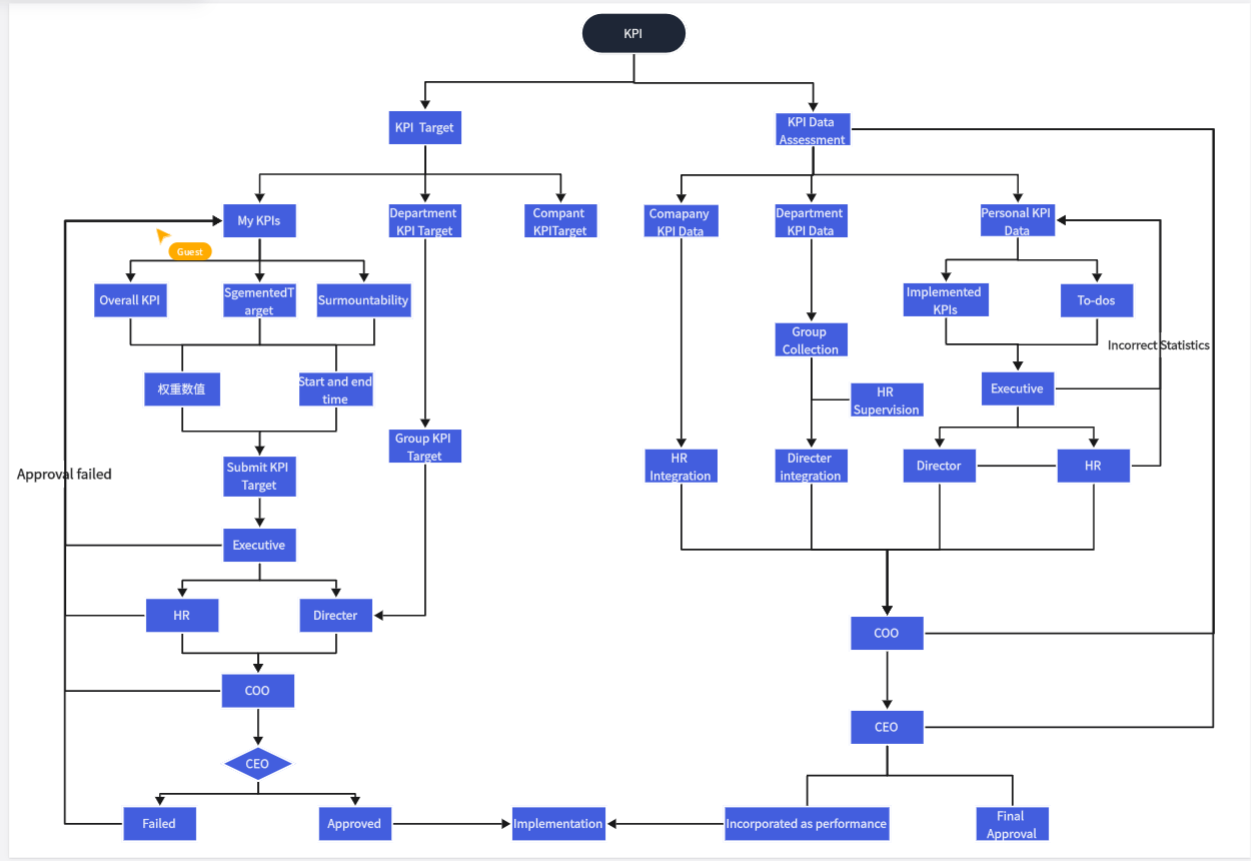For business, effective tools that guide strategic planning, performance measurement, and goal alignment are essential to achieve the ambitious goals of the business. Objectives and Key Results (OKRs) and Key Performance Indicators (KPIs) stand out as indispensable frameworks for driving organizational performance and facilitating continuous improvement. In this comprehensive guide, we delve into the intricacies of OKRs and KPIs, exploring their definitions, components, and real-world applications. Let's embark on this journey to uncover the power of OKRs and KPIs in shaping the future of organizations.
What Are OKRs (Objectives and Key Results)
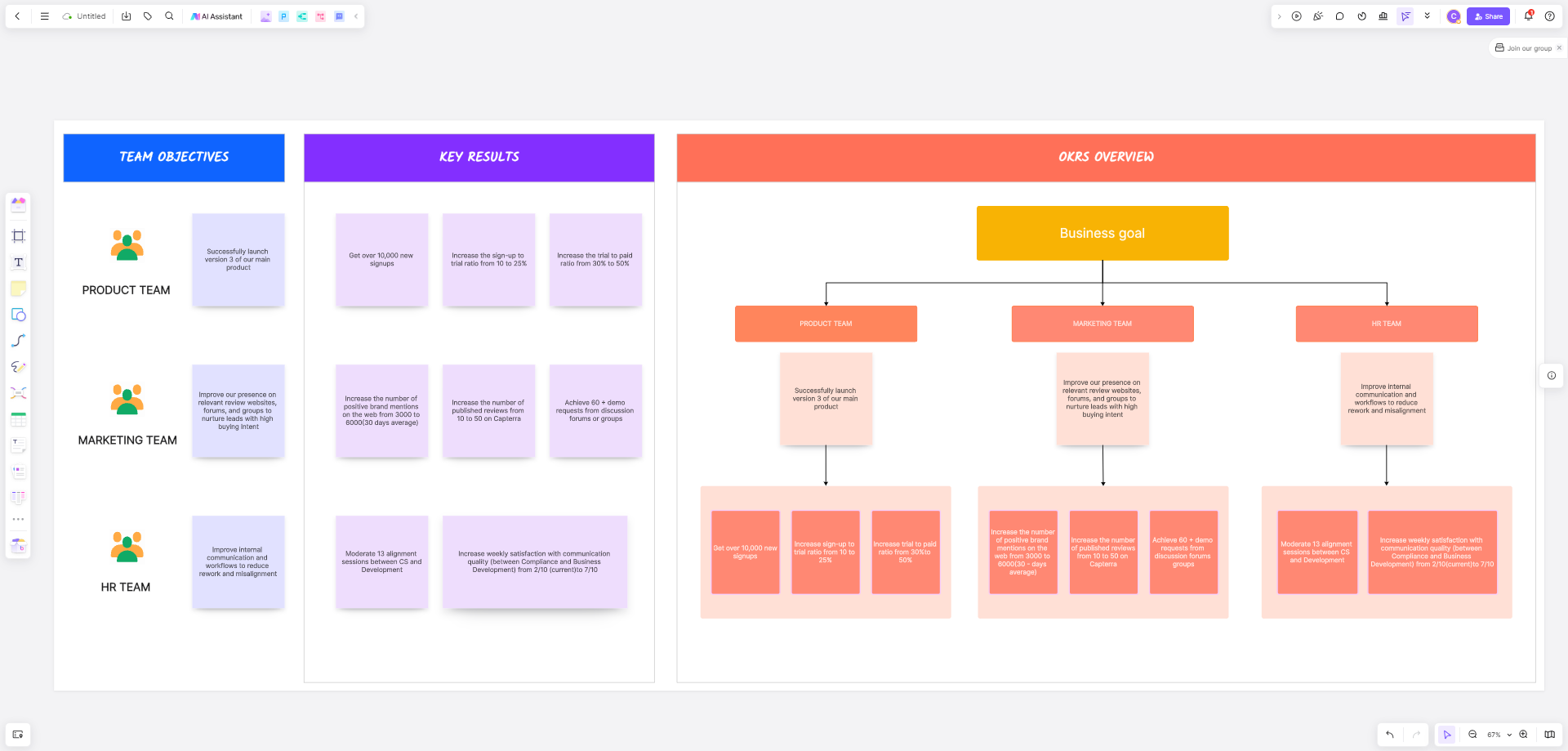 Try Now
Try Now
Definition and Purpose
Objectives and Key Results (OKRs) are a powerful framework for setting and achieving goals within an organization. It helps to create alignment and engagement around measurable goals.
The purpose of using OKRs is to ensure everyone in the organization understands the objectives of the company and how they can contribute to these objectives. This method fosters transparency, aligns teams and individuals with organizational goals, and provides a clear path to success.
Components of OKRs
OKRs consist of two basic components:
- Objectives: Objectives are ambitious, inspiring, and qualitative descriptions of what you hope to achieve. They should be short, memorable, and motivating.
- Key Results: Key Results are measurable, quantitative outcomes that track the achievement of the Objective. They should be specific, time-bound, aggressive yet realistic.
Typically, for each objective, you will have 2-5 key results.
Examples of Effective OKRs
Here are some examples of effective OKRs:
E.g.1
- Objective:
Improve customer satisfaction
- Key Results:
- Increase customer survey satisfaction score from 8.0 to 9.0.
- Reduce average customer complaint resolution time from 48 hours to 24 hours.
- Achieve a Net Promoter Score (NPS) of above 80%.
E.g.2
- Objective:
Enhance our online presence
- Key Results:
- Increase website traffic by 30%.
- Gain 5,000 new followers on our social media platforms.
- Increase the average session duration on our website by 2 minutes.
Remember, effective OKRs are clear, actionable, ambitious, and measurable. They align and engage teams around common objectives, creating a sense of purpose and direction.
What Are KPIs (Key Performance Indicators)
Definition and Significance
Key Performance Indicators (KPIs) are quantifiable measurements that help organizations track performance over time. These metrics are used to determine how effectively a company is achieving key business objectives. KPIs provide a framework for strategic, operational improvement and a basis for decision-making.
The significance of KPIs lies in their ability to provide measurable proof of progress towards specific business goals or objectives. They allow for performance comparison, provide actionable feedback, and help focus attention on what matters most.
Types of KPIs
There are several types of KPIs, including:
- Quantitative KPIs: These are numerical data that can be measured. Examples include sales revenue, profit margins, and customer retention rate.
- Qualitative KPIs: These are descriptive characteristics that can be observed but not measured. Examples include customer satisfaction, brand recognition, and employee morale.
- Leading KPIs: These predict future events and trends. They can help an organization assess the likely outcome of its strategic initiatives. Examples include the sales pipeline, employee satisfaction, and training levels.
- Lagging KPIs: These reflect historical performance and confirm success or failure. Examples include total sales last quarter, customer churn rate, and post-project reviews.
Examples of Common KPIs Across Industries
Here are examples of commonly used KPIs across various industries:
- Sales/Marketing: Conversion Rate, Cost Per Lead, Customer Acquisition Cost
- Customer Service: First Response Time, Customer Satisfaction Score (CSAT), Net Promoter Score (NPS)
- Human Resources: Employee Turnover Rate, Absenteeism, Training Costs Per Employee
- Finance: Gross Profit Margin, Operating Cash Flow, Current Ratio
- Manufacturing: Production Volume, Reject Ratio, Machine Downtime
In summary, the use of KPIs is essential in managing performance and achieving strategic objectives in all areas of business operations. By tracking the right KPIs, companies can identify areas that need improvement and take action based on data-driven insights.
What Are the Differences Between OKRs and KPIs

Key Distinctions Between OKRs and KPIs
Objectives and Key Results (OKRs) and Key Performance Indicators (KPIs) are two powerful, yet distinct tools used in business performance management.
- Purpose: OKRs are typically used to set, track, and achieve high-level organizational goals. They focus on pushing boundaries and inspiring teams towards aspirational outcomes. KPIs, on the other hand, are performance metrics used to measure the effectiveness of various business operations in achieving defined objectives.
- Nature: OKRs are usually qualitative, ambitious, and time-bound while KPIs are quantifiable, ongoing operational measurements.
- Frequency: OKRs are usually set on a quarterly or annual basis, allowing for strategic adjustment and realignment. KPIs are often monitored continuously or at regular intervals to keep a constant check on business performance.
How They Complement Each Other in Driving Business Performance
While distinct in their purposes, OKRs and KPIs can effectively complement each other to drive overall business performance:
- Setting Direction: OKRs can help set the strategic direction by defining what needs to be achieved. KPIs can then provide operational benchmarks that contribute towards these high-level objectives.
- Driving Alignment: OKRs create alignment across different levels of the organization, ensuring everyone is working towards common goals. KPIs align operational activities with these strategic goals, reinforcing the connection between daily work and big-picture objectives.
- Providing Feedback: Both OKRs and KPIs provide valuable feedback on performance - OKRs reflect on strategic progress while KPIs shed light on operational efficiency and effectiveness.
Real-world Examples of OKRs and KPIs in Tandem
- In a software company, an OKR might be to "Increase user engagement on our platform". The key results could include "Increase daily active users by 20%" and "Increase average session duration by 15%". Corresponding KPIs could be the current number of daily active users, average session duration, and bounce rate.
- In a sales department, an OKR might be "Expand into new markets". Key results could be "Secure 50 new clients in market X" and "Increase revenue from market X by 30%". The KPIs could include the number of new clients acquired, client retention rate, and revenue growth in market X.
By integrating OKRs and KPIs, businesses can ensure they're not only setting ambitious goals but also effectively tracking the day-to-day operations that contribute to those goals. This holistic approach allows for more strategic decision-making and ultimately, stronger business performance.
How to Implement OKRs and KPIs for Strategic Growth
Steps to Effectively Set OKRs and KPIs
Successfully implementing OKRs (Objectives and Key Results) and KPIs (Key Performance Indicators) requires a structured approach. Here are the steps to effectively set these powerful management tools:
- Understand Your Strategy: Start with a clear understanding of your organization's strategic goals. What does success look like for your company?
- Develop OKRs: Translate your strategic goals into specific, measurable, time-bound OKRs. Objectives should be ambitious and inspiring while Key Results should be quantitative measures of success.
- Identify Relevant KPIs: Determine the operational performance indicators that align with your key results. These should be the critical factors that directly contribute to achieving your objectives.
- Communicate: Share your OKRs and KPIs with all stakeholders. This creates transparency, aligns everyone's efforts, and fosters a sense of collective ownership.
Best Practices for Tracking and Measuring Progress
After setting your OKRs and KPIs, it's important to track and measure progress effectively. Here are some best practices:
- Regular Reviews: Conduct regular review meetings to discuss progress on OKRs and KPIs. This helps identify any roadblocks early and adjust strategy as needed.
- Use Tools: Utilize software tools for tracking and visualizing progress on your OKRs and KPIs. These can provide real-time insights and facilitate communication.
- Balance between OKRs and KPIs: Ensure a healthy balance between meeting your KPIs (operational efficiency) and striving towards your OKRs (strategic effectiveness). Focusing too much on one can neglect the importance of the other.
Strategies for Optimizing Performance Based on OKR and KPI Insights
Here are strategies to optimize performance based on the insights you gain from tracking OKRs and KPIs:
- Data-Driven Decision Making: Use the data from your OKR and KPI tracking to make informed decisions. If a strategy is not working as planned, don't hesitate to adjust or pivot.
- Promote Learning Culture: Encourage a culture where failures or shortcomings are seen as opportunities to learn and improve, not just setbacks.
- Reinforce Accountability: If certain objectives or key results are not being met, identify the reason and hold relevant teams or individuals accountable.
- Celebrate Successes: When milestones are reached or objectives are achieved, celebrate these successes. This boosts morale and motivates the team to keep striving for better results.
In conclusion, when implemented effectively, OKRs and KPIs can drive strategic growth by aligning everyone around common goals, facilitating effective performance tracking, and enabling informed decision-making.
Simplifying OKRs and KPIs Management with Boardmix
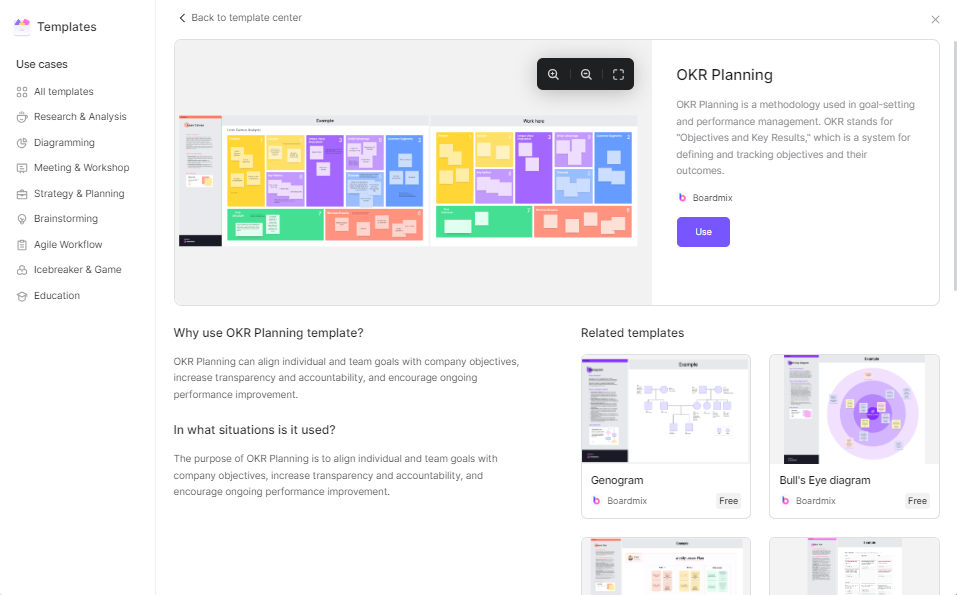
Boardmix is an innovative online tool that can streamline the management of Objectives and Key Results (OKRs) and Key Performance Indicators (KPIs). With its intuitive interface and robust features, Boardmix allows organizations of all sizes to effectively set, track, and achieve their goals and objectives.
Whether you are a start-up trying to navigate your initial growth phases or a well-established organization working towards maintaining your market position, Boardmix can play a pivotal role in your journey. It provides you with the necessary tools to set ambitious objectives, align them with measurable results, and track key performance indicators critical to your operations.
Key Features of Boardmix
Boardmix comes loaded with an array of features that facilitate seamless OKRs and KPIs management:
- Dynamic Goal Setting: Easily set, update, and track OKRs with the dynamic goal-setting feature. This allows you to create and modify objectives as per changing business needs and priorities.
- OKR and KPI Tracking: Track all your critical performance metrics in real time. Boardmix helps you align with your team always and keep a pulse on how your company is performing.
- Visual Dashboards: The tool provides comprehensive visual dashboards that give a clear, concise snapshot of your OKRs and KPIs. You can monitor progress at a glance, fostering informed decision-making.
- Collaboration Features: Enhance team collaboration with shared view options, progress updates, and interactive commenting features. This ensures everyone in the team is aligned with the company's strategic goals.
Getting Started with Boardmix
Ready to take your business performance management to the next level? Here's how to get started with Boardmix:
1.Sign Up: Visit the boardmix.com and sign up for a new account. You can start with for free, and also can choose the plan that best fits your organization's needs.
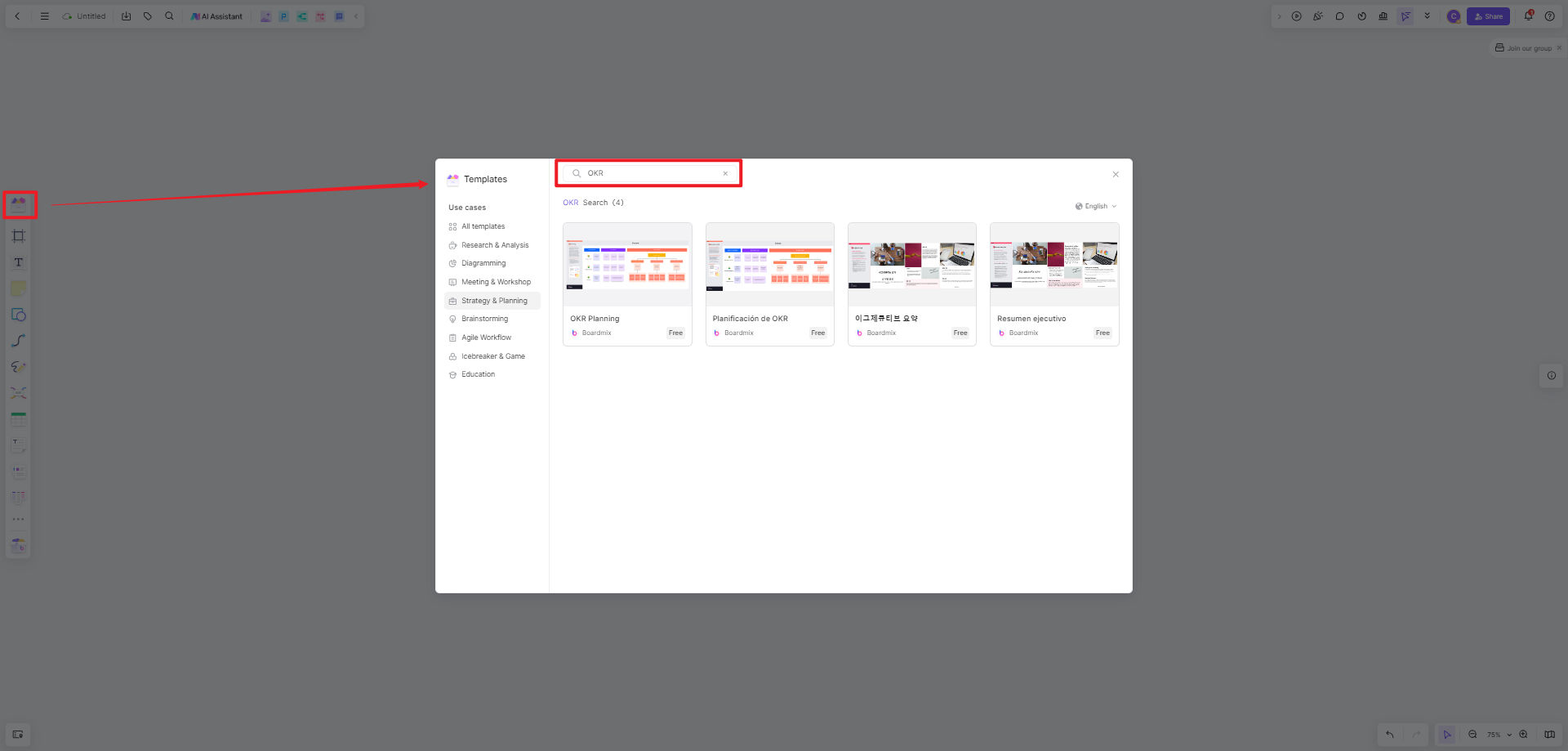
2.Set up Your OKRs and KPIs: Use the intuitive interface to create your initial OKRs and KPIs. Remember to make your objectives inspiring and key results measurable.
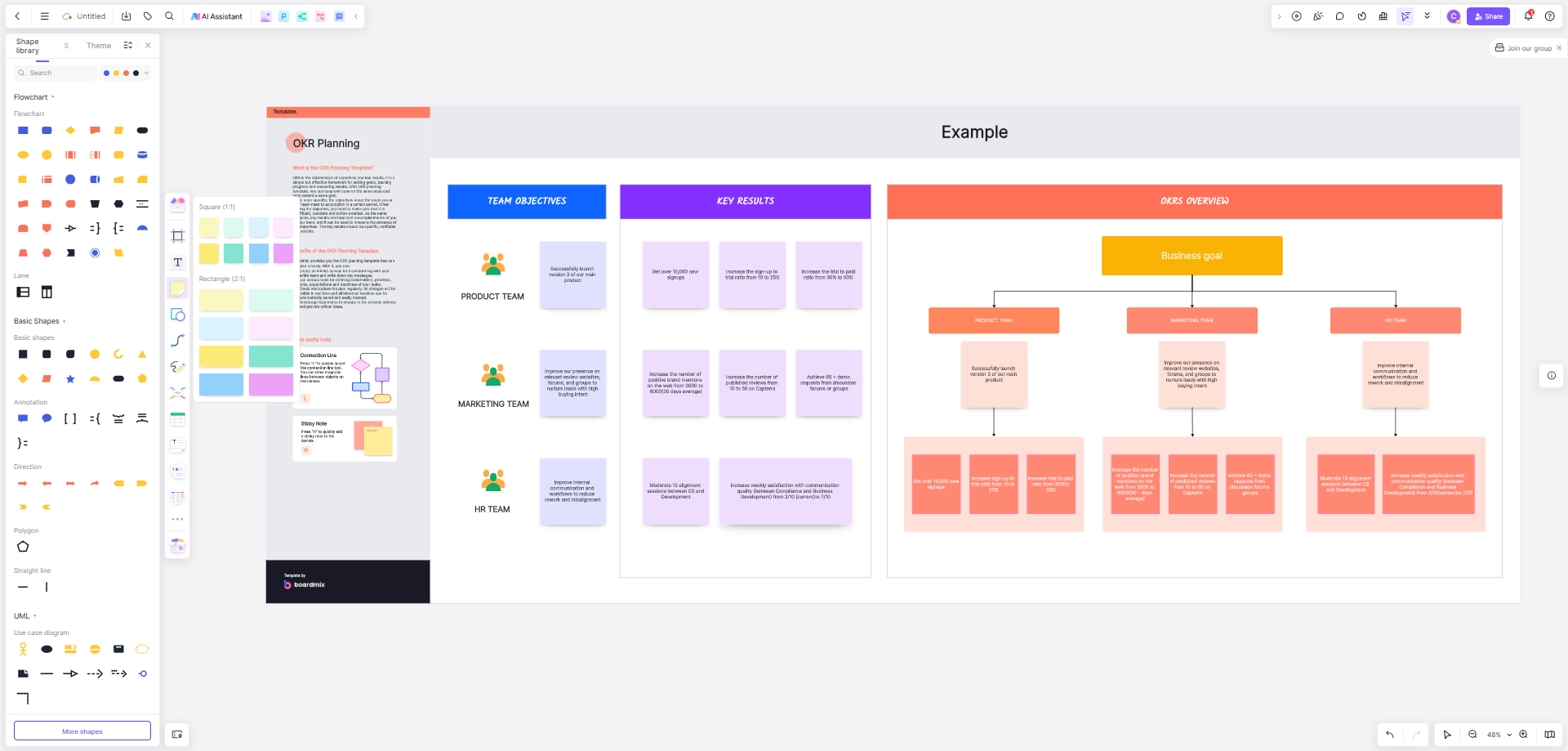
3.Create a board for management: Click the New board button and then you can start your program. Also, there are many ready-made templates for free, you can search for them in the Template library, or choose one project management tool on the left of the board.
4.Invite Your Team: Invite your team members to join the platform and align them with the company's strategic objectives.
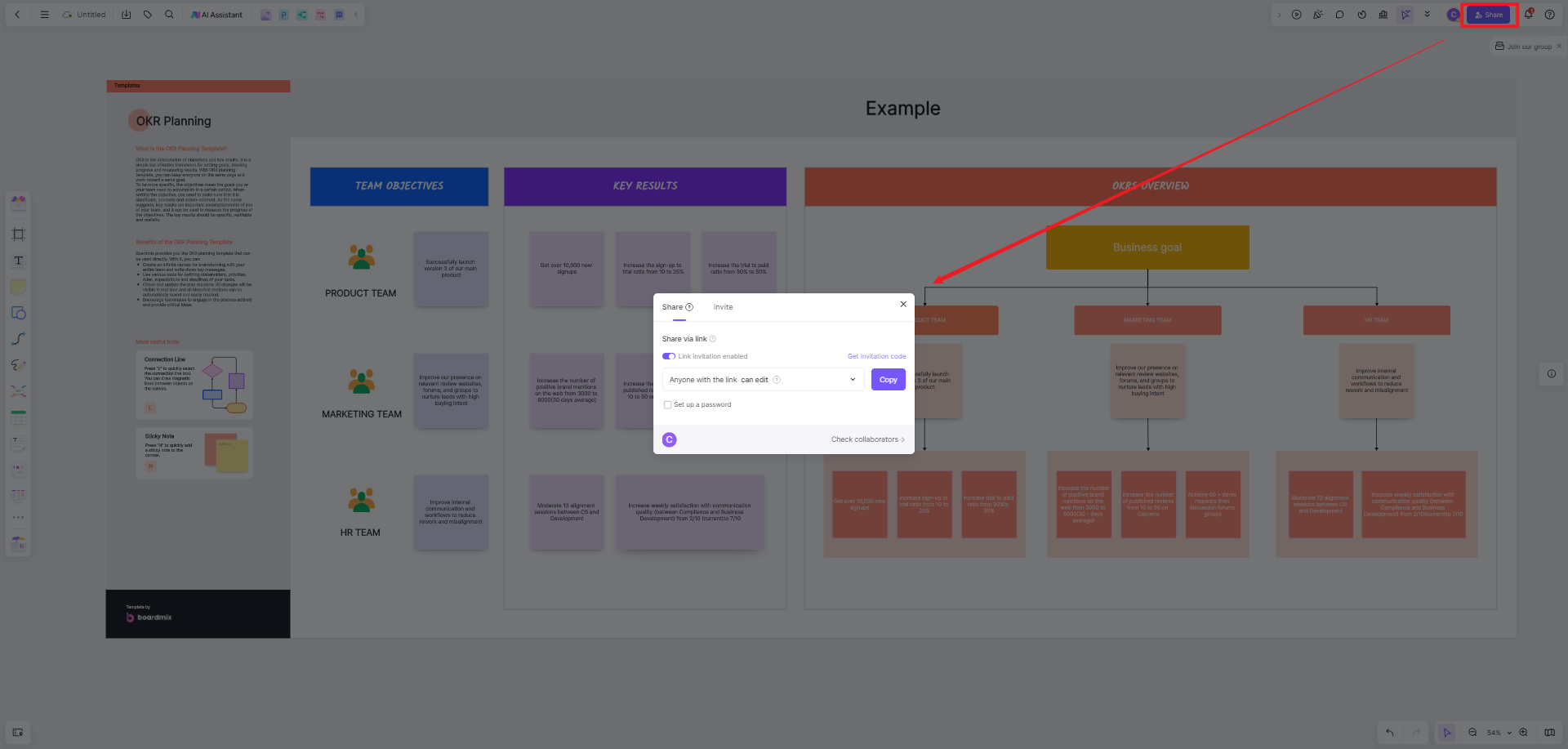
5.Track Progress and sharing: Start tracking progress on your OKRs and KPIs using visual dashboards and regular updates by sharing the Boardmix link for collaboration.
Whether you manage your team with OKRs or KPIs, Boardmix helps you visualize your team's performance and the program process. With Boardmix, managing OKRs and KPIs becomes not just simpler but also more effective. So why wait? Get started with Boardmix today and embark on a journey towards more strategic, data-driven growth!






